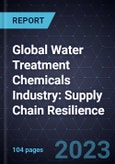Raw Materials Innovation and Value Chain Collaboration are Prominent Strategies in Building Resilience in Water Treatment Chemicals Supply
Water treatment chemicals play a significant role in water pre-treatment for municipal and industrial use and the treatment of municipal and industrial wastewater for environmentally safe disposal. The growing popularity of chemical-based mobile water treatment services, installation of zero liquid discharge and minimal liquid discharge infrastructures, and the need for potable water of adequate quality will contribute to increased demand for water treatment chemicals.
However, the distribution network for water treatment chemicals faces complex challenges, including the risk of natural disasters and pandemics, regulatory changes, and market fluctuations. Any disruption caused by these events in the supply of water treatment chemicals will have significant repercussions on public health. An effective and robust supply chain of water treatment chemicals is essential for public health and environmental sustainability. This report explores the resilience of the water treatment chemicals distribution network, emphasizing the importance of adapting to potential disruptions and building a robust system capable of withstanding unexpected challenges.
This study covers various chemical types, including coagulants, flocculants, activated carbon, pH conditioners, disinfectants, and fluoridation chemicals. It assesses key strategies and best industry practices through case studies to enhance the resilience of these chemical types. Resilience in the water treatment chemicals distribution network involves proactive measures to identify risk parameters and develop mitigation strategies. It includes distribution network optimization, supplier diversification, and the adoption of digital technologies for real-time monitoring and decision-making.
The study discusses the significance of stakeholder collaboration, including chemical manufacturers and water treatment plants, in fostering resilience. Incorporating sustainable practices, such as using environmentally friendly chemicals and energy-efficient processes, is also considered an essential component of a resilient distribution network.








